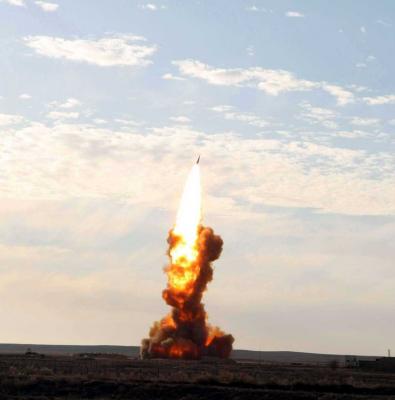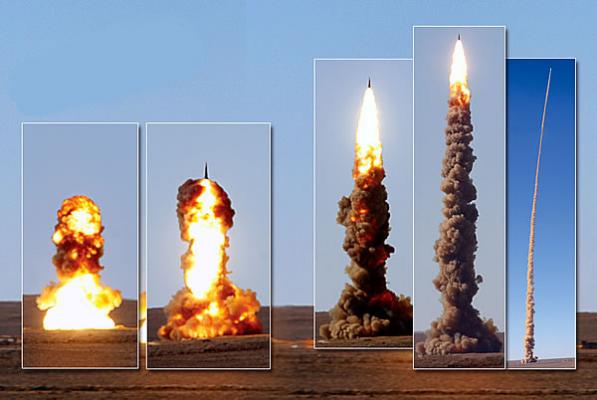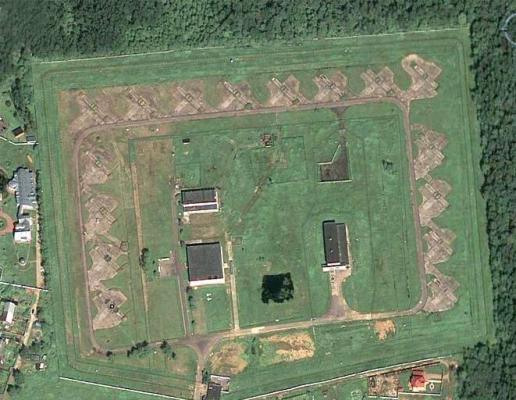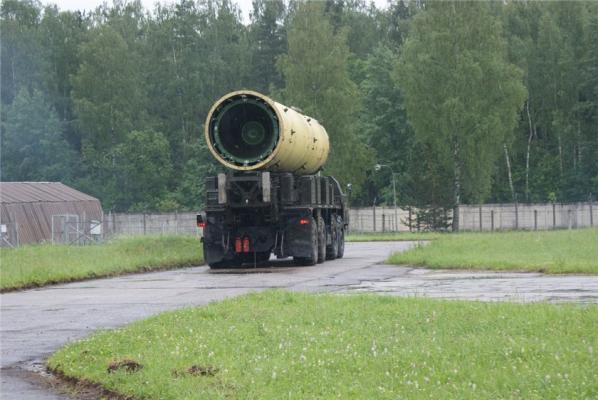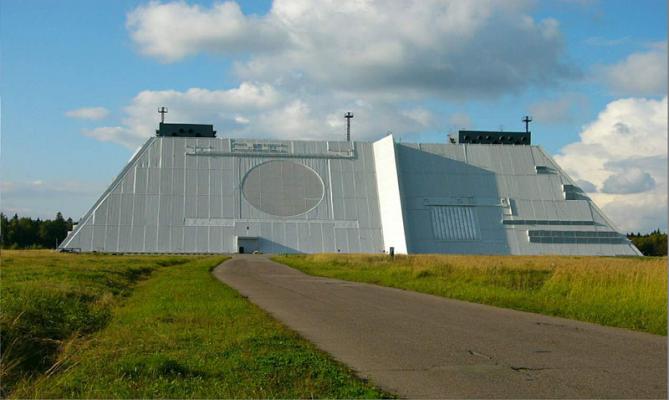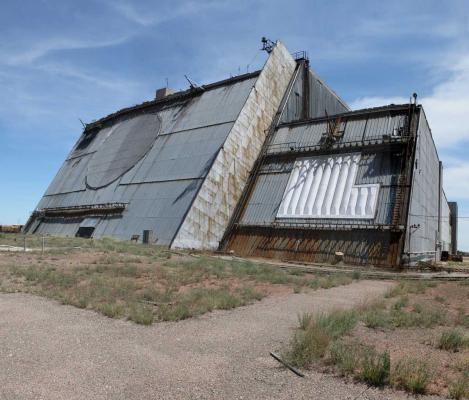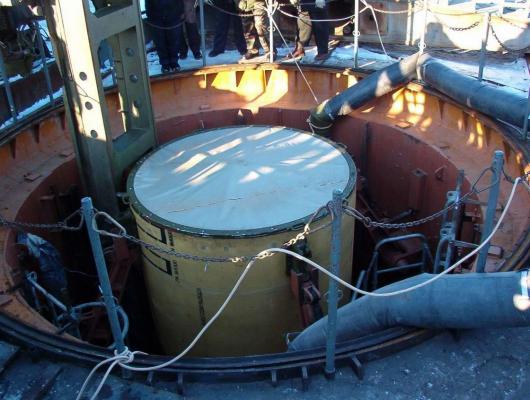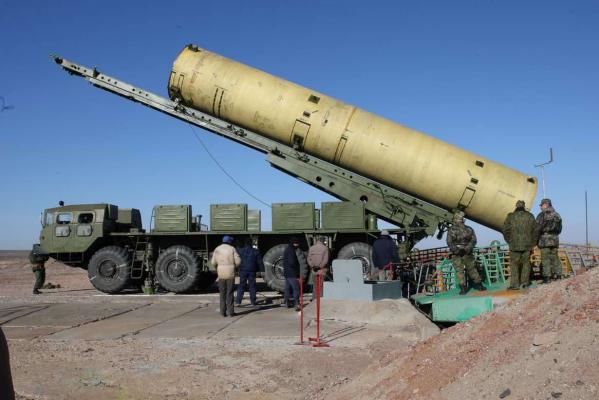The multi-channel missile defense system of the Central Industrial District and Moscow of the second generation A-135 is a development of a similar complex of the first generation A-35. The upgraded version of the A-35 missile defense system - the A-35M system - was developed by NIO-4 OKB-30 under the leadership of G.V.Kisunko until its removal in 1975. In parallel with G.V.Kisunko works on new anti-ballistic missile defense system were started by order of Minister V.D.Kalmykov at the end of 1968 by a group of specialists of the Ministry of Radio Industry of the USSR under the leadership of A.G.Basistov. By the end of 1969 the concept of a two-tier missile defense system was preliminary agreed with the Ministry of Defense of the USSR. In 1970 the subject of anti-ballistic missile defense was completely transferred under the control of the Ministry of Defense of the USSR - on January 17, 1970 the specialized CNPO "Vympel" was formed, the scope of which included the problems of anti-ballistic missile defense, warning systems of missile attack and space control, etc. Development of the system at the STC TsNPO "Vympel" was conducted on the subject of research "Fon-1".
Resolution of the USSR Council of Ministers No. 376-119 on creation of the A-135 anti-missile defense system with the Amur long-range intercept firing system and the Amur-P prototype range was issued on June 10, 1971. The project provided for the creation of three Amur firing systems at a distance of 600-800 km from Moscow and three universal close-intercept systems S-225, which would minimize damage from the use of anti-missile defense systems with powerful thermonuclear warheads in the long-range, and improve the reliability of intercepting attacking warheads. In December 1971, the advanced design of the A-135 system was completed (Research Institute of Radio Equipment of the USSR Ministry of Radio Industry), the advanced design of the Amur Firing System (STC TsNPO "Vympel", chief designer - A.G.Basistov). The development of the two-stage long-range intercept intercept missile of the A-925/51T6 Zaatmospheric train (designation US/NATO - ABM-4 Gorgon/SH-11) was entrusted to the Fakel ICBM, Chief Designer - P.D.Grushin. After the conclusion of the ABM Treaty in June 1972, the redesign of the ABM system and the Amur Missile Defense System was started to accommodate all facilities on an area of 100 km in diameter (Moscow Oblast, Russia). After the conclusion of the ABM Treaty in June 1972, the Amur ABM system and the Amur firing system were redesigned for the 100 km diameter area (Moscow region), the S-225 complexes were excluded from the system, and the high-speed ORS-1/5YA26 anti-missile missiles developed for these complexes by the Novator Design Bureau under the leadership of L.V. Lyuliev (since 1985 - Chief Designer P.I. Kamnev) - the future 53T6 (new index since 1973) - were included in the near (second) atmospheric echelon of the A-135 system. A.G.Basistov was in charge of development of the corrected project. The conceptual design of the A-135 system in 1973 was proposed by the USSR Ministry of Defense and with some comments approved at the end of 1973. In the same 1973 A.G.Basistov was appointed the chief designer of A-135 missile defense system. The following versions were considered as the system's phased array radar: the Don-2N (RTI, chief designer V.K. Sloka); the Neman radar (NIIAR, chief designer Yu.G. Burlakov); the Istra-2 radar (NIIRP, chief designer G.V. Kisunko). The project of radar "Don-2N" became the winner.
In 1974 after signing the Protocol to the ABM Treaty under the leadership of A.G.Basistov the third version of A-135 ABM system project was developed. In 1975 the system project was discussed in the USSR Ministry of Defense, the project was sent for revision with some remarks. In 1975 A.G.Basistov was appointed General Designer of SKB-2 of TsNPO "Vympel". - M.G.Minasyan was appointed first deputy of A.G.Basistov for A-135 system (until his death on 16.09.1998, which was followed by E.P.Andreychuk). The conceptual design of the A-135 missile defense system with the elimination of customer's comments was developed in 1976. The system under the sketch design was included:
- command and control center;
- data transmission and communication system;
- a firing system consisting of the Don-2N multifunction radar and two echelon anti-missile launch positions;
- technical positions of missile preparation.
The system was created as a two-tier system with 51T6 long-range missiles (see photo), which represented the development of the A-35 anti-missile system and 53T6 medium-range missiles originally developed as part of the C-225 KB-1 universal complex project. The ABM system facilities were designed to be spaced up to 100 km apart. In the A-135 system it was assumed that anti-missile missiles with nuclear ballistic missiles of various capacities would be used on missiles of different echelons.
Decision on creation of a polygon sample of the A-135 missile defense system - "Amur-P" 5Zh60P for testing components and the system as a whole was adopted in 1974. Construction and deployment of a polygon complex of the missile defense system was mainly carried out in 1976-1979. The complex consists of the Don-2NP radar (test range), 5K80P command and control center with Elbrus type computer, firing complex and 5Ya67 data transmission system. By 1978 creation of "Amur-P" system A-135 firing complex. 5G60P was generally completed. Tests of missiles and other system facilities were conducted at the 6th (PR 51T6), 8th (Don-2NP and 5K80P radars) and 35th (PR 53T6) sites of the 10th State Research Range Sary-Shagan ("Range A", ABM-X-3A/SH-08). Priozersk, the Kazakh USSR). In 1973 the first experimental sample PR 5YA26 was created and delivered for testing. The first launches were carried out with an inclined launcher at an angle of 20 ° to the horizon - the very first, throw launch, was held November 27, 1973 at the 35th site of "Landfill" A ". Until the second launch inclusive, the rocket was not equipped with onboard equipment. Stage/HF separation was not carried out. From the third - the missile was equipped with standard equipment. Since 1978, from the 7th to 11th launches, factory tests were conducted using the means of the first prototype of the system ("Azov"). Starting with the 12th launch in 1979, the means of the second prototype of the system ("Amur-P") were used. On the whole, the tests of the PR were very difficult due to the peculiarities of the missile. From 15 subsequent launches into six missiles were destroyed and until the 17th launch it was not possible to provide reliable radio communication with the board. The point is that the rocket designers, taking care of strength and aerodynamics, took the bottom part of the launch and march stage of the rocket for the installation of onboard antennas. As tests have shown, in flight, these antennas are fully shielded by plasma formed during high-speed flight in the atmosphere. After detailed analysis, the rocket designers had to install the antennas on the rocket body in front of the gas-jet control system nozzles. Moreover, the original system of switching the antennas depending on the position of the missile's axis in relation to the radio equipment of the complex was developed. However, despite the difficulties, starting from the 17th launch it was possible to obtain a stable connection via the control channel, and from the 20th launch - via the sighting channel. In addition,
In the course of testing of the test site sample of the Amur-P missile defense system, the following methods of verification and testing without actual missile launch were developed:
- "Hangar" - check the radar system with the control board of the onboard radio equipment of the missile, located on the ground;
- "Lie down launch" - check the functioning of the complex to capture the missile, which is being trained in the technical position, with the installation of radio communications through a remote antenna; during modeling on the missile involved all control systems without turning on the engines.
- "Cold Launch" - check of all means of the complex in the mode of preparation and execution of the launch with the development of all operations, including irreversible, on the anti-missile, installed in the SHPU of the starting position, with the explosion of pyropatrons in the outgoing armored cassettes;
- "Electronic launch" - check of the complex facilities functioning when working on natural by-pass or simulated ballistic targets using program simulators of near and far interception missiles.
In August 1979, for the first time there was a flush start of PR 53T6 from the control panel. PR flew out of the mine and self-destructed after about 5 seconds. In this test a defect in the mine gas deflector design was found: there were holes in it and at the start of the PR it created a pressure of 15 atm. and it worked like a piston, flying out of the mine at a distance of about 20 m, compressing the TPC and pulling out the rails with a support ring (total weight of about 7 tons). It was also stated that the poor quality of the welds caused the steel structures to break off. Later, the thickness of the metal cup of the mine was increased from 7 mm to 32 mm, turning it into a power structure. The first launch of the anti-missile in a closed control loop was made in July 1981. In April 1982, the real ballistic target, 8K65 MRBM, was successfully intercepted. The divergence of the target at a range of 40 km was about 50 meters, which is quite enough to hit the target. One of the tests of the system took place on June 18, 1982 as part of the largest exercises of the USSR Armed Forces (called in the West "seven-hour nuclear war"). Two 5Zh60P PR systems launched from Range A intercepted the 15Zh45 Pioner MRBM launched from Kapustin Yar and the R-29 SLBM launched from the 667B Muren project of the Northern Fleet. Factory testing of the complex with a set of equipment of the first stage of the complex was started in November 1982 and completed in March 1984 (8 launches of 51T6 missiles, including 4 as part of the complex, 5 launches of 53T6 missiles, including 4 in the closed loop control, 9 entries of custom-made ballistic targets, 27 entries IPZ, flying by aircraft, cycles of modeling and functional control of the complex). In March 1984, according to a number of data, the State tests of the 53T6 missile itself were completed.
In 1986 tests of the complex with the computer "Elbrus-1" and special calculator (equipment of the first stage) were completed. Gradual installation of the second stage equipment with a more advanced computer "Elbrus-2" at the range complex was carried out from March 1984 to October 1987. Tests of the system A-135 "Amur-P" with the equipment of the second stage were conducted from March to October 1987. (2 launches of 51T6 missiles, 5 launches of 53T6 missiles, 2 conductors of custom ballistic targets and 36 conductors of targets). The results of the tests concluded that the TTH complex meets the specified, including the destruction of the latest maneuvering HC MRBM type "Pershing-2". After some modifications of the system, one more stage of control tests of the polygon sample was carried out - January-July 1988 (2 launches 51T6, 3 launches 53T6, 5 launches of custom ballistic targets and 16 by-pass targets). State trials of the A-135 system near Moscow began in 1989. At the same time, at the Amur-P range complex, as part of the state trials, anti-missile launches were conducted - 3 launches 51T6 and 4 launches of serial 53T6, 14 custom-made ballistic goal postings were made. At tests of anti-missile defense system the considerable attention was paid to an estimation of operational, constructive and reliability characteristics, an estimation of noise protection (a special interfering complex was used). Transport and resource tests of rockets, transport and installation machines were carried out, influence of gas jet of starting rockets on elements of a starting position and their mutual influence at starts with an interval in 1 second was investigated. Tests were conducted by storing two 53T6 missiles in a horizontal position for 10 years and two 51T6 rocket propulsion systems in a horizontal and vertical position for 11 years. State tests of A-135 system at Amur-P range complex were successfully completed on December 4, 1989. In addition, during the testing period, additional control of the background target environment and confirmation of the characteristics of combat orders of complex targets in the launches of special ballistic missiles during the testing of the ABM system A-135 at the range of a unique radar "Neman-P". In the same years the measurements made with its help allowed to test additional target selection algorithms for A-135 missile defense system.
Resolution of the USSR Council of Ministers No. 585-119 on construction of the A-135 system in the Moscow Region was issued on June 7, 1978. Construction of A-135 anti-missile defense system facilities was started in 1980 and mainly completed in 1983. In 1984-1987 the systems for support of maneuvering ballistic purposes (in connection with the placement of American MRBM "Pershing-2" in Europe) were modified. As of summer 1986 at the objects of A-135 anti-missile defense system the installation of equipment was under way, at the Don-2N radar the installation of an autonomous power supply source was under way, the construction of 53T6 missiles' shaft booster according to the schedule and 51T6 missiles' shaft booster according to the schedule was under way. Despite all the difficulties, the supply of missiles A-925/51T6 and ORS-1/53T6 as part of the A-135 missile defense system was started in 1990 and in December 1990 the system was accepted for trial joint operation. At the same time, in 1989-1990, at the Amur-P range complex, experimental work was carried out to expand the capabilities of the A-135 system in terms of reducing the lower and increasing the further limits of the target area using the 53T6 missile, increasing the maneuverability of this missile, as well as equipping it with a new non-nuclear warhead under the "Aircraft-M" program (5 launches of 53T6). At the Amur-P complex, during the entire period of its operation (removed from service in 1990), 19 launches of 51T6 missiles, 37 launches of 53T6 missiles, 28 launches of custom-made ballistic targets and 1900 modeling cycles were conducted. Series production of the PR 53T6 at plant No.8 (M.I.Kalinin plant, Sverdlovsk (Yekaterinburg), now a part of NPO Almaz-Antey) and launching missiles at the starting positions of the A-135 missile defense system were started in 1989 and in 1990, respectively, and the completion of the A-135 system with missiles was completed in 1992; serial production, according to a number of data, was curtailed in 1993. 22 launches of the PR 53T6 were made from the ShPU at the 35th site of the "Etilen" test site of the Sary-Shagan range between 1982 and 1990 (Stages 1, 2 and 3 of the tests, State Tests, the "Aircraft-M" program).
On February 11, 1991, the air defense units began an experimental combat duty on the A-135 complex. Completion of the A-135 system with missiles was completed in 1992 and February 17, 1995 the Decree of the President of Russia Boris Yeltsin on restoration of the A-135 anti-missile defense system, ensuring constant operation of the system and the beginning of work on its modernization was issued. The Moscow A-135 missile defense system was initially adopted by the Russian Armed Forces, consisting of two positions PR 51T6 for 16 boosters (32 missiles; Naro-Fominsk and Sergiev Posad, Moscow region) and five positions PR 53T6 for 12 or 16 boosters (68 missiles; cities Lytkarino and Skhodnya (16 boosters), Korolev, Vnukovo and Sofrino (12 boosters)). The system was put on combat duty on December 1, 1995 and in 1996 the A-135 missile defense system was officially adopted by the Russian Air Defense Forces. For its creation the chief designer of the "Don-2N" radar V.K. Sloka was awarded the title of the Hero of the Russian Federation in 1996, and a large group of participants in the development and creation of the ABM system was awarded with orders, medals and honorary titles of the Russian Federation. In 1997 the developers of the A-135 missile defense system were awarded State Prizes of the Russian Federation. Yu.F.Voskoboev has been the chief designer of A-135 anti-ballistic missile defense system since October 2002.
In 2006 51T6 missiles were taken off the armament and only 68 PR 53T6 missiles remained in the system. As of 2011, the A-135 missile defense system is part of the 9th ABM Division of the 3rd Special Purpose Rocket and Space Defense Army of the Russian Armed Forces. The work is being done not only to preserve, but also to further improve the combat capabilities of the A-135 anti-missile defense system. This activity is carried out in a number of areas: for example, one of the most important is the fullest possible use of the modernization potential of the 53T6 anti-missile - this was stated by the General Designer of the A-135 anti-missile defense system A.G. Basistov after the end of the State tests: "The system showed significant reserves by all parameters. Lyuliev 53T6 high-speed missiles can hit ballistic targets at ranges 2.5 times greater and at altitudes 3 times greater than we have now certified them. The system is ready to carry out tasks to defeat low-orbit satellites and other combat missions. The data obtained earlier in the framework of the Aircraft-M Design Bureau are also used in the implementation of modernization measures. Equally important is the modernization of the transmitting part devices and the development of improved components of the combat algorithms of the Don-2N/5N20 radar (BURTS-B field work). There are also other serious works in progress to expand the capabilities of the A-135 system - in particular, in the first half of the 2000s, in order to replace the multifunctional computer system based on the Elbrus-2 computer, the installation, testing and acceptance of the local area network (LAN) based on the high-performance server Elbrus-90 micro with a gradual increase in its characteristics (according to a number of published data, in the near future the server will be replaced by an even more powerful server). Work was carried out to extend warranty periods of all systems of the complex, first of all PR 53T6 within the framework of RCD "Priozersk" (from initial 10 years to 15-20 years and further). In the period 1991-2010 (exercises, launches within the framework of the program of extending the warranty period and various design documentation), 8 launches of PR 53T6 were carried out at the 35th site of the "Etilen" test site of the Sary-Shagan range, the last of which took place on October 26, 2010. In total, 45 launches of PR 53T6 have been conducted.
Assessing the capabilities of the created second-generation A-135 anti-missile defense system, it can be noted that this system, taking into account the proven correctness of the technical solutions developed in the design of this system, its high performance and combat capabilities, is able to protect the capital from the limited impact of the most advanced missiles. The A-135 anti-missile system is capable of intercepting enemy ballistic missiles and their head units flying at altitudes from 5 km to near space at speeds up to 7 km/s. The combat capabilities of the A-135 system make it possible to: paralyze the threat of a possible low-level nuclear missile strike; raise the threshold for a nuclear retaliatory strike; ensure the survivability of objects at the highest levels of command, including those making decisions on retaliatory actions; provide accurate information about space objects in a peaceful environment or in the initial period of a non-nuclear conflict, as well as defeat high-altitude hypersonic targets attacking Moscow.
Composition:
The 53T6 anti-missile (see the proposed scheme) is a stage with a launch and march RTDT, an inseparable compartment with a micro-RTDT control and a detachable uncontrollable head end containing a special BC and control system. Hull type - carrying pointed cone without protruding elements. According to a number of data, the PR body is made of composite materials by winding with the use of titanium alloys and high-strength steels in some places; the tip of the missile head part is quartz ceramics. Almost the entire missile body is covered with a special multifunctional light heat-protective coating protecting the missile from hot gases during launch and from aerodynamic heating. The missile's onboard cable network is entangled in the casing, the ribbon cables of the through cable network are laid in the engine casing during its manufacture (in a special channel between the "cocoons" of the winding).
The 5C73 53T6 launch and march engine was designed by the Design Bureau-16 (Kazan Engine Building Design Bureau, later - Soyuz Design Bureau); Chief Designer P.F. Zubets, Leading Designer - I.H. Fakhrutdinov. Specification for the creation of the engine for the 53T6/PS-1 missile was received in 1969. (according to other data - 1970). According to some information, the engine is divided into launch and marching parts, with firmly-bonded, specific channel and slot-shaped charges of solid mixed high-energy fuels of different composition with high specific impulse. Engine nozzle - central, fixed, recessed. Launch of the rocket - gas-dynamic from the transport and launch container on its own engine with the help of guides on the inner surface of the TIC. Missile control at the initial stage of the flight - gas-dynamic by injection into the critical part of the nozzle of the starting and marching engine of combustion products from the chamber of the RDTT (according to unconfirmed data, the thrust vector control at the site of the starting and marching engine is carried out by injection of liquid freon in the critical part of the nozzle). Correction of the missile's flight path, including at the final stage of flight before separation of the GC - gas-dynamic using pulsed gas-jet solid-fuel micro-motors directed perpendicular to the longitudinal axis of the missile.
The control system of the radio command missile includes a transponder placed on board the missile (responsible designers - V.I.Tolstikov and V.I.Dolgiy) and autopilot 5A13 (responsible designer P.M.Kirillov) of the development of the Central Design Bureau "Diamond" with float sensitive elements. In creating the control system, unique technologies were applied, which allowed the missile to reliably perform tasks at overloads over 100 g. The electronic units used in the missile had a special anti-shock system "pouring" in combination with increased resistance to foammable substances. At the stage of prototype launch testing, a software device ("programmer") developed by Experimental Design Bureau "Novator" was installed on the missile; in combination with an inclined PU, the programmer replaced the autopilot. From the moment the command "Enabling Missile Preparation (MTBF)" was issued, the following operations were performed at the Central Station of the complex: "range zeroing", "issuing current missile declination commands", "determining the time of issuing the command "Launch", "counting the reverse time before issuing the command "Launch". The last value of declination commands is memorized using the "Start Accepted" signal - these values of declination commands are executed by the autopilot of the PR during engine operation, when radio communication with the PR is difficult or absent. The same command is used to memorize the last value of "zero range". When the "Break" signal is received, the flight time counter of the PR is started. After the motor is cut off, radio communication with the PR respondent is established: the PR coordinates are determined by the respondent's signal, guidance and other commands are transmitted via the command station channel (CTC). The command receiver and responder antennas are located in pairs of 2 on the rocket body.
Missiles guidance and control of the whole complex is provided by 5K80 command and computer center with 5N20 multifunctional radar "Don-2N" (Sofrino, Moscow region) with 4 fixed PHARs with broadband sounding signal. The prototype - radar 5N20P "Don-2NP" ("P" - polygon version of the equipment, prototype) - is installed at the testing ground in Sary-Shagan (Priozersk city). The command and computer point of the 5K80 PRO system with the "Elbrus" computing system has been developed by SKB-2, the developers A.G.Basistov and V.S.Burtsev. The prototype of the radar 5H20 "Don-2N" - 5K80P ("P" - a polygon version of the configuration, a prototype with a computer 65I6) - is installed at the testing ground in Sary-Shagan. The elements of the complex were separated at a distance of up to 100 km (radar, control, rocket control, technical positions of missile preparation) and connected to each other by the data transmission system 5Y67. The combat control of the interception complex is fully automatic. The development of the Don-2N radar was conducted by the A.L. Mints Radio Engineering Institute of the USSR Academy of Sciences since 1972, Chief Designer V.K. Slok, Chief Designer of Antenna Systems G.G. Bubnov. At the first stage the radar with analog signal processing and with computing complex "Elbrus-1" was created, at the second stage - radar with digital signal processing and VC "Elbrus-2". The Elbrus-2 computing system (developed by the Institute of Precision Mechanics and Computer Engineering of the Russian Academy of Sciences, Chief Designer V.S.Burtsev) is a multi-processor computing system with paralleling of calculations, the speed of 125 million operations per second ("Elbrus-1" - 15 million operations per second). Modular architecture that allows replacement of modules without stopping the system. Hardware support for the main structures of high-level programming languages. The system uses precision high-frequency printed circuit boards and power dissipation removal systems. To prepare the system for Elbrus-1 testing, an experimental group was established in 1975, which prepared the system for three years. Tests of Elbrus-1 system were conducted from 1978 to 1980 on the basis of NPO Almaz. In 1985 state tests of the modernized system "Elbrus-2" (chief designer V.S.Burtsev) were successfully completed. Construction of the Don-2N radar was started in 1979, construction was completed in 1981, installation and adjustment of equipment was completed in 1986.
MLRLS - monopulse multifunctional radar station of centimeter range with large module phased active antenna arrays, electronic control of characteristics and position in the space of transmitting and receiving directional diagrams, digital processing of radar signals. It is a stationary ground complex of radiotechnical equipment connected with the computing system KVP-135 and placed in one of two blockaded buildings of a special engineering structure. The structure is a correct quadrilateral truncated pyramid with the length of the side at 6 m - 144 meters, on the roof - 100 meters, the height of 33.6 m. On all four side surfaces of the building there are round phased antenna arrays for escorting targets and counter missiles (antenna diameter 16 m) and square (10,4 x 10,4 m) phased antenna arrays for transmitting commands for pointing on board counter missiles. Radar station "Don-2H" provides simultaneous view of the entire upper hemisphere in the area of responsibility of the complex. The radar operators regularly perform training firing at the ballistic missiles using special computer programs simulating real combat conditions. The programmes are divided into different trajectories of the ballistic missile flight, the number of warheads and decoys, and the degree of difficulty of engagement. All defense systems are involved in the training battle. The battle is fought in real time and in real geographical dimension. In a peaceful environment, the Don-2N radar operates in low emitted power mode. The station is switched to a more active mode in case of need for detailed reconnaissance and control of outer space, etc. According to NATO classification, the Don-2N radar is designated as PILL BOX, and its polygon prototype - as HORSE LEG. The unique capabilities of the Don-2N MLR were clearly demonstrated by the results of work in one of the joint experiments with the U.S. to detect small space objects, conducted under the program ODERACS 1 (Orbital DEbris RAdar Calibration Spheres) to test the possibility of tracking the so-called "space debris", during which in February 1994. from the Discovery Space Shuttle on the STS-60 mission, special microsatellites were launched into outer space using a special OSDS (ODERACS Sphere Delivery System) device, named from ODERACS A to ODERACS F - 6 metal spheres with diameters of 5, 10 and 15 centimeters (2 spheres with diameters of 2, 4 and 6 inches, respectively). Fifteen-centimeter spheres detected all the radars involved in the experiment. Spheres 10 centimeters in diameter were seen by only three radars: two Russian and American radars COBRA DANE in Alaska. The Don-2N radar, the only one of all radars involved in the world at a range of 1500-2000 km, was able to detect and build the trajectory of the smallest space object-ball with a diameter of 2 inches (5 cm). The Don-2N radar has also been integrated into the Russian Federation's unified early-warning and space surveillance system.
The development of warheads to address the problems faced by BMD systems is worthy of a separate comment. To solve this problem it was necessary to develop special boosted (i.e., reinforced by initiation of thermonuclear reactions already in the process of charge nucleus compression - "thermonuclear" neutrons, due to their high energy, effectively interact with the nuclei of fissile materials) charges in essentially asymmetric configuration. The scientific problem, which had to be solved in the course of development, was connected with the necessity to correct the initial asymmetry in the process of implosion of the central part of the nuclear charge at its triggering and providing stability of the booster mode. This fundamental problem was successfully solved in VNIIEF under the scientific supervision of R.I.Ilkaev. In the 70-80s of the XX century at VNIIEF in the interests of working out the possibilities of creating a domestic missile defense under the scientific leadership of Yu. E.D. Yakovlev and V.D. Kharkin (VNIIEF-1 Design Bureau) were responsible for these developments. Among the charges created in this way is a special nuclear charge AA-84 for the 53T6 missile (according to some data, the product power - 10 kt). Ammunition for this nuclear charge and corresponding automation systems were created in VNIIEF Design Bureau-2 under the leadership of S.G. Kocharyants. It should be noted that in order to develop the charges for the country's anti-missile defense and air defense systems, more than 50 nuclear tests have been conducted and a unique scientific and technical potential has been developed, which up to now has been the basis for both the design of new thermonuclear charges and the testing of intensively developing mathematical simulation methods. Nuclear testing of the 53T6 anti-missile BC was carried out at the Semipalatinsk test site and at the 108-k special facility where the test adits for VNIIEF and VNIITF were located. At the same time, in 1989-1990, as part of the "Aircraft-M" program, tests of PR and non-nuclear shrapnel-phase HC of directional type were conducted.
Basing of anti-missile missiles - group (the group consists of 12 or 16 SAMs, located several tens of meters apart) in the mine PU of the development of GSCB "Spetsmash" under the leadership of V.Barmin (development began in December 1971), in the fiberglass TIC (see the proposed scheme). Protective device of sliding type BCP, weight 25 tons, of 2 parts (see photo1, photo2) . According to some information, the rate of fire of the control loop cover is 0.4 s. Creation of a SLU for these PRs was a difficult task - it was necessary to ensure that the starting PR left the mine within one second after receiving the start command. This was due to: the high thrust-to-weight ratio of the missile, which is many times higher than the thrust-to-weight ratio of ICBMs of the same class; providing the opening of the protective device (roof) of the mine, which has a significant mass, in a fraction of a second, and issuing a signal about it to the launch control system of the PR; creating a system of temperature and humidity conditions in the trunk of the mine to ensure long-term storage of TLC with solid fuel PR and special charge. TPK in SHU is depreciated. Construction of slurry control systems was started at positions near Moscow in 1980. Since 1982, equipment assembly was in progress, preliminary readiness - 1985.
Transportation and storage of anti-missile interceptors in the slurry control system is carried out in a transport and launch container, where all technological works on checking anti-missile interceptors at the technical position, storage of anti-missile interceptors at the technical position and in the slurry control system, transportation and launch of anti-missile interceptors are carried out. The TIC is hermetically sealed. Inside it the necessary temperature, pressure and humidity are maintained, which allows to store the missiles in the open air, in vertical and horizontal position for a long time. During transportation and storage, the TPK is closed at both ends with special lids, which allows to use for heating the missile in the TPK heating system connected to the conveyor. The covers are removed during installation in the control panel. The missile is launched from the closed TPK, for which it is closed at the front with a special rubber cap, and with the rear - rubber bottom. When the missile is launched, the front hood and the bottom of the TPK are broken through at the same time by the anti-missile and engine gas jets respectively. Automatic control and testing stations for 51T6 and 53T6 anti-missile missiles (AKIPS) are produced by the DMZ. The 5T93 transport vehicle on MAZ-543M chassis is used for transportation of the missile-carrying system and its installation on the charging machine. The vehicle is equipped with a missile heating system for winter season (see photo). There are at least two variants of the 5T93 vehicle.
The 5T92 transport and charging machine on the MAZ-543M chassis and the 23D6 automated control and test mobile missile interceptor station are used to install the TPC in the starting shaft.
According to the western data, by 1990 there were carried out research and development works on creation of mobile modification of ORS-1M/53T6M (Chief Designer - P.I. Kamnev) with PU on the basis of 6-axis chassis MAZ-547 similar to PU BRSD "Pioneer".
There are assumptions (based on the special conditions of the ABM Treaty of 1972, the presence of TPK, the dimensions of the missile) that the 53T6 missile silo launcher with recharge drum-type mine was developed for multiple use of the mine and to increase the combat productivity of the system.
Characteristics:
| Engine length without nozzle, m | 7 |
| Engine traction | 1000 t |
| Engine running time, s | 4 |
| Length, m | ~ 12 |
| Diameter, m | ~ 1,7-1,8 |
| Weight | 10000 kg |
| Mass of PPP | ~ 700 kg |
| BC mass | ~ 150 kg |
| Range, km | 80-100 |
| Defeat height, km | 5-30 |
| Rocket speed, km/sec | 5,5 |
| Speed climbing to a height of 30 km, s | 6 |
| Acceleration time to maximum speed, s | 4 |
| Exit time from the start of the mine, s | 0,4 |
| Maximum overload: - longitudinal - transverse |
210g 90 g |
| Warranty period of operation | 10 years, with the prospect of extension to 15-20 years. |
| Tactical and technical characteristics of "Don-2N" radar | |
| Antenna diameter, m | 16 |
| Emitted power, MW | 250 |
| Ballistic target detection range, km | 1200-1500 (according to other data up to 3700 km) |
| Space target detection range, km | 600-1000 |
| View angle by azimuth, deg | 360 |
| Accuracy of coordinate measurement: - in range, m - at the corner of the place, deg. |
200 (100 after modernization) 0,06 (0,02-0,04 - after modernization) |
| Number of simultaneously accompanied ballistic targets | up to 100 (up to 30 before the upgrade) |
| Number of simultaneously launched anti-missile interceptors | no more than 100 (according to some reports, before the modernization - 36 pcs. (16 51T6 and 20 53T6)). |
| Notification time | to 9 minutes. |
Testing:
As of 01.01.1950, the factory batch of 230 shells was completed and sent to the Pavlograd test site.
In November 1949, pre-factory tests of 34 shells were carried out together with the fuse B-377 during which cases of missiles were revealed.
Special tests carried out to determine the causes of deficits showed that the most probable cause was an increased release of unburned reactive charge particles at the end of the active section of the trajectory.
In order to eliminate this phenomenon, in December 1949 a bench-top refinement of the engine was started with regard to aperture enhancement and ensuring that the powder charge was fixed in the chamber. After the end of the bench work and experimental firing for checking the reinforced aperture, the factory batch of projectiles was to be equipped with modified apertures on site and presented for factory tests in February 1950.
Sources:
- ПерминовА.В., АвраменкоС.Д., ГарбаоьА.Н., ДавиденкоВ.Н., ДюрягинМ.Г., ЛаптевМ.В., МолодцовС.М., ОлейниковИ.В., ХоменкоИ.Е. "Космическиевойска". Москва 2003 г.
- Андрюшин И.А., Чернышев А.К., Юдин Ю.А. "Укрощение ядра. Страницы истории ядерного оружия и ядерной инфраструктуры СССР". С., С.: Красный Октябрь, 2003
- А. Курикша. Создание СПРН и СККП // www.vko.ru
- В.Д. Анисимов, Г.С. Батырь, А.В. Меньшиков, В.Д. Шилин. СККП России: вчера, сегодня, завтра. // www.vko.ru
- В. Репин. Основные этапы создания ракетно-космической обороны. // www.vimpel.ru
- А. Хорев. Национальная безопасность. Система контроля космического пространства РФ. // www.rosbaltnord.ru
- Мертвые зоны в противоракетной обороне. // kompromat.flb.ru
- А. Хореев. Национальная безопасность. Контроль космического пространства. Что мы можем? // myarh.ru
- В.Д. Анисимов, Г.С. Батырь, А.В. Меньшиков, В.Д. Шилин. Система контроя космического пространства Российской Федерации. // www.vimpel.ru
- В. Морозов. История разработки и создания системы предупреждения о ракетном нападении - история ЦНПО «Вымпел». // www.vimpel.ru
- В. Морозов. Всевидящее око России. // nvo.ng.ru
- А. Потехина. На космических рубежах.
- В. Морозов. Против обезглавливающих и разоруживающих ударов. // www.vimpel.ru
- О. В. Голубев, Ю. А. Каменский, М. Г. Минасян, Б. Д. Пупков. Прошлое и настоящее российских систем противоракетной обороны (взгляд изнутри). // www.vimpel.ru
- В. Шилин. Важный инструмент стратегического сдерживания. // www.vimpel.ru
- В. Мейлицев. Перехват. // www.specnaz.ru
- militaryrussia.ru
- Михаил Ходаренок. 10-й испытательный полигон ПРО Сарышаган. МРЛС «Дон-2НП». // www.vpk-news.ru
- Михаил Ходаренок. Успешный пуск противоракеты типа ПРС-1. // www.vpk-news.ru
- picasaweb.google.com
- www.okb-novator.ru
- www.vniief.ru
- kursakov.boom.ru
- warfare.ru
- army.lv
- www.military-informer.narod.ru
- www.russianforces.ru
